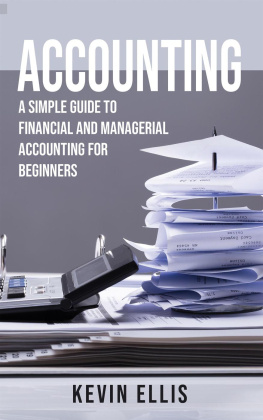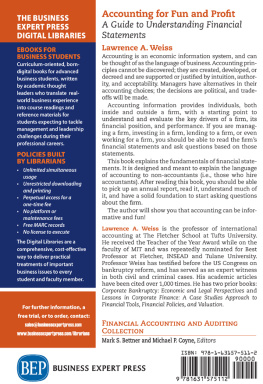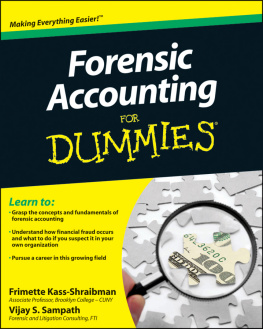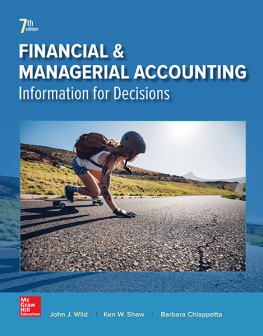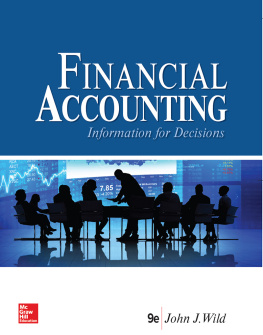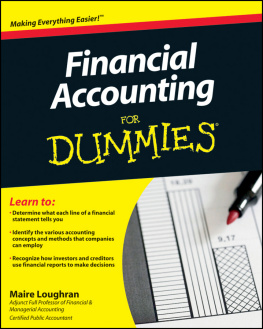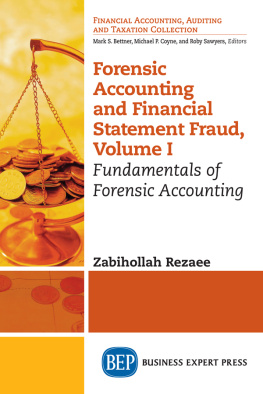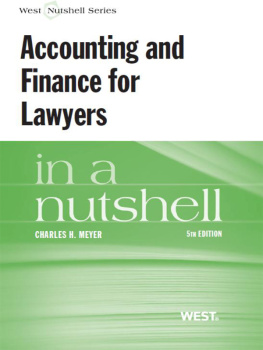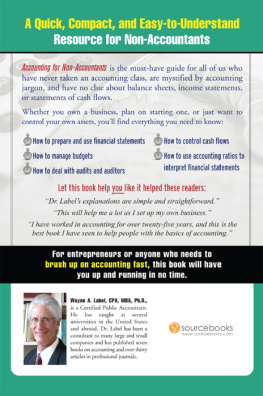Contents

Accounting Irregularities
in Financial Statements

Accounting Irregularities in Financial Statements

A Definitive Guide for Litigators, Auditors and Fraud Investigators
BENNY K. B. KWOK


First published 2005 by Gower Publishing
Published 2016 by Routledge
2 Park Square, Milton Park, Abingdon, Oxon OX14 4RN
711 Third Avenue, New York, NY 10017, USA
Routledge is an imprint of the Taylor & Francis Group, an informa business
Copyright 2005 Benny K.B. Kwok
Benny K.B. Kwok has asserted his right under the Copyright, Designs and Patents Act 1988 to be identified as the author of this work.
All rights reserved. No part of this book may be reprinted or reproduced or utilised in any form or by any electronic, mechanical, or other means, now known or hereafter invented, including photocopying and recording, or in any information storage or retrieval system, without permission in writing from the publishers.
Notice:
Product or corporate names may be trademarks or registered trademarks, and are used only for identification and explanation without intent to infringe.
British Library Cataloguing in Publication Data
Kwok, Benny K.B.
Accounting irregularities in financial statements: a definitive guide for litigators, auditors and fraud investigators
1. Misleading financial statements 2. Accounting fraud
3. Corporations - Accounting - Corrupt practices
I. Title
657.3
ISBN 9780566086212 (hbk)
Library of Congress Cataloging-in-Publication Data
Kwok, Benny K.B.
Accounting irregularities in financial statements: a definitive guide for litigators, auditors and fraud investigators / by Benny K.B. Kwok.
p. cm.
ISBN: 0-566-08621-2
1. Corporations--Accounting--Corrupt practices. 2. Financial statements. 3. Fraud. 4. Auditing, Internal. I. Title.
HF5686.C7K85 2005
657.3--dc22
2005005509
Typeset by IML Typographers, Birkenhead, Merseyside.
Contents
Accounting Irregularities in Financial Statements is primarily designed for executives, litigators, auditors, accountants, investigators, legal counsels, law enforcement officers and other business professionals who have the responsibility of upholding the integrity of financial statements and deterring frauds and accounting irregularities. Regulators and standard-setters will find this book an excellent source of ideas and references when considering reforms and regulations. Educators and prospective accountants (including business and economics students) will see this book as an alternative, inspiring way of understanding accounting and how to stay alert to accounting irregularities in financial statements.
Capitalism and our modern society depend on trust: trust that governments are honouring their pledges; trust that citizens are fulfilling their obligations; trust that corporations are being diligently run; and trust that borrowers are paying their lenders. Most of these trusts hinge on properly prepared financial statements.
Accounting is not an exact science. Judgements must be exercised in many areas. In this sense, accounting is naturally creative, and changes are a constant feature. If you give a dozen accountants the same set of information and transactions about an organization and asked them to prepare a set of financial statements, it is likely that there would be variations and different results. What would change the phenomenon is the existence of a regulator who is often charged with the responsibility of reducing the variation of possible outcomes. The amount of the reduction would depend largely on the regulators view of the role of judgement within the financial reporting environment.
This book is about accounting irregularities in financial statements. Accounting is a well-established subject, supported by a wide range of studies and literatures. Irregularities refer to accounting treatments and practices which are irregular and different from the acceptable standard, the generally accepted accounting principles (GAAP). Financial statements refer to the reports prepared by organizations in accounting for the results of the transactions and events in a defined time-frame.
There are two tiers of accounting irregularities. The first tier is to take advantage of the built-in flexibility of the GAAP. That means the irregularities may well fall within the accepted practices; but with a dishonest intent. Sometimes, the first tier is called creative accounting. Strictly speaking, as long as the dishonest intent is proven, the perpetrators are still in breach because compliance with the GAAP also requires the correct selection and application of accounting practices within the GAAP. The selection and application processes also count in deciding whether or not an accounting irregularity has been committed.
The second tier refers to the attempts to breach the appropriate the GAAP and trying to hide the malpractices and irregularities. Once found, there would be no debate over the legitimacy of the malpractices and irregularities because, unlike the first tier, they are clearly in violation of GAAP (subject to court or disciplinary rulings).
This book uses the term organizations to denote unincorporated businesses, commercial corporations, government authorities, quasi-government bodies and non-profit-making organizations because the distinctions amongst all these entities are not important as far as the contents of this book are concerned. What matters most is that the financial statements of all these organizations are bound by the GAAP, any departure from which are deemed to be accounting irregularities.
We have used the term auditor to represent a range of parties, including investigators, tax assessors, forensic accountants and regulators. In many cases of accounting irregularites, officers in different institutions and authorities are asked to investigate the matters. They have their own scope and power to conduct the investigation. Going into the detail of the investigation will be beyond the scope of this book, thus we use one universal term to represent someone who is to investigate and report the findings of the accounting irregularities in question.
Cases in this book include fictitious names and any similarities are purely coincidental. Cases are adopted to illustrate the perpetration of accounting irregularities in financial statements. They only focus on particular aspects of a transaction(s) and are not a comprehensive discussion of all the relevant factors.
This book is organized so that readers who seek to learn about a particular topic do not have to read the entire book or preceding chapters to gain an understanding from the selected reading. However, the cost of presenting more self-contained chapters is some repetition. Readers of the entire book will note that some topics that have already been covered are briefly discussed a second (or third) time. While this is done to a very limited extent, it is done by design, allowing readers of selected chapters to gain the maximum from the time they invest in the book. This format may be helpful for the professional who has very high time costs.


